The history of the first serial Soviet helicopter Mi-1
We can say that the Mi-1 helicopter began story and the experimental design helicopter bureau bearing the name of the famous aircraft designer Mikhail Mil. It was founded on December 12, 1947. Over its history, Mil Design Bureau has designed 13 main helicopter models and more than 200 of their modifications - from light to super-heavy classes, including the most popular Mi-8 multi-purpose helicopter in world history. But it all started with the Mi-1 helicopter, which was mass-produced in the USSR, and then in Poland in the passenger, postal, agricultural, sanitary and, of course, military versions. The machine is widely used in the air force and civilian aviation Soviet Union. About the excellent flight performance of the rotorcraft "hare" are best said by 27 world records that were set on a helicopter in the period from 1958 to 1968.
Helicopter Mil first (GP-1)
All attempts that were made to create a practical helicopter until the middle of the 1940-s ended in nothing. The helicopter turned out to be a much more high-tech machine than many thought, the creation of rotary-wing vehicles was under the force of only truly experienced design teams. In this case, the prewar years were years of experiments in the field of helicopter. The greatest spread before the Second World War received autogyros. The rotor of such aircraft rotated in flight itself under the action of air flow, it did not have a mechanical drive from the engine. In the USSR, the first autogyros under the designation A-4 designed by Vyacheslav Kuznetsov entered service with the Red Army in the 1934 year. At the very beginning of World War II in the country, a squadron of military autogyros A-7-3a (the first serial rotary-wing aircraft in the country) of designer Nikolay Kamov was formed. This squadron was used by Soviet troops in the Smolensk defensive battle in the summer of 1941. The engineer of this squadron was Mikhail Mil, the designer of helicopters glorified in the future.
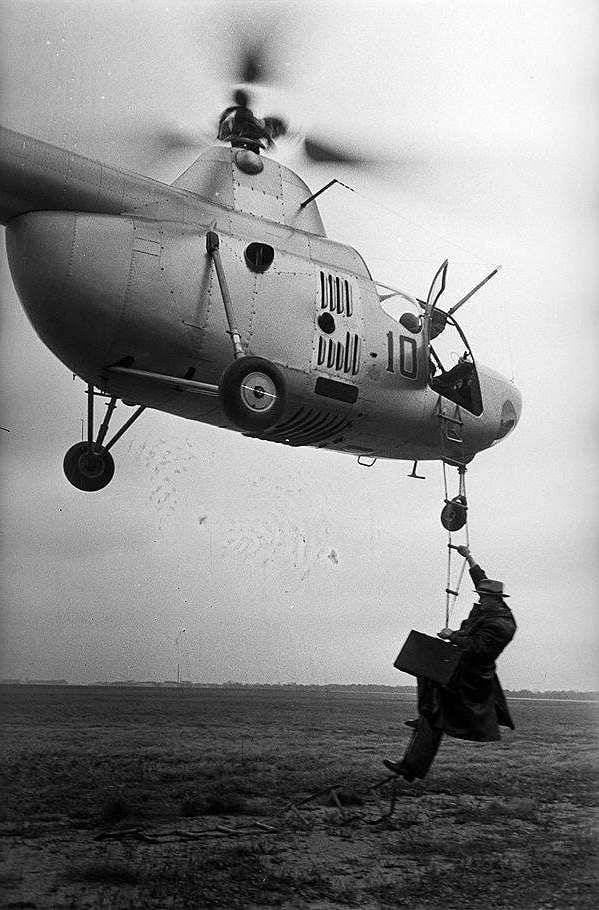
The prerequisites for the transition from experimental helicopters to target helicopters, which could be launched into mass production, took shape in the Soviet Union in the middle and second half of the 40s of the last century. At the same time, the country chose the path of creating helicopters, as they say, of the classical scheme - with one rotor and one tail rotor. This helicopter scheme still dominates worldwide in the field of helicopter construction. At the same time, in the war and the first post-war years in the USSR, not a single KB was engaged in single-rotor helicopters. In 1945, Mikhail Mil began, on his own initiative, working on an experimental helicopter, which he named EG-1. This machine was a three-seater helicopter, built according to the classic single-rotor scheme.
In 1946, a helicopter laboratory was formed at TsAGI, headed by Miles. Under his direct supervision, a universal test bench of a full-scale helicopter installation (NSU) was created here. This stand was necessary for testing and research of full-sized rotors, as well as refining the design of the main parts of helicopters. It is on the basis of the NSU that the helicopter was developed, which received the GM-1 index (First Mile Helicopter). A December 12 1947 saw the light of the historic decree “On the creation of a communications helicopter for the USSR Armed Forces”, this was the starting point in the history of the Milvian company, today it is Moscow Mil Helicopter Plant JSC that is part of the Helicopters holding Of Russia. " In 1947, it was the Allied OKB-4 of Minaviaprom.
Due to the lack of own production facilities at OKB-4 at that time, the first three prototypes were built at an aircraft factory in Kiev. Tests of helicopters were organized at the airfield Zakharkovo, near the famous airfield Tushino. Despite a number of plane crashes, the tests could be called successful. The helicopter confidently hung in the air, was distinguished by good stability in flight and excellent maneuverability. During the tests of the rotary-wing machine, the flight speed of 175 km / h and the dynamic ceiling - 5200 meters were reached. Starting from 1949, the helicopter passed state tests that did not reveal any complaints about the car, except for the magnitude of the vibration and the level of piloting. In the 1950-s, a sufficient number of different tests were carried out, which checked the helicopter operation in severe weather conditions, in mountainous conditions and in emergency landing conditions.
Already 21 February 1950 of the year was received a resolution of the Council of Ministers of the USSR on the commencement of mass production of the GM-1 helicopter, under the new designation Mi-1. Initially, the new rotary-winged machine was developed as a coherent one, but later on the helicopter was used in various roles. Serial production of the helicopter continued from 1952 to 1960 year at aircraft factories in Moscow, Kazan, Rostov-on-Don and Orenburg. In the period from 1956 to 1965, the helicopter was also produced in Poland in the city of Svidnik. In total, during the series production 2680 helicopters were assembled, including more than 1500 (like SM-1 and its modifications) - in Poland.
The design of the Mi-1 helicopter and its modifications
The Mi-1 helicopter had a classic single-rotor scheme with a three-blade main and tail steering screws. In front of the fuselage there was a cabin with a pilot’s workplace and a sofa on which two passengers could freely fit. Behind the cab was an engine compartment with an AI-26 GRF piston engine, developed by designer Alexander Ivchenko. This engine was manufactured in Zaporozhye at the Progress plant; it produced the maximum power of the 575 HP. The engine power was enough to accelerate a two-ton car up to the speed of 185 km / h, the practical ceiling slightly exceeded three kilometers.
When designing the helicopter, Soviet designers took into account the experience of a foreign helicopter building, but they managed to create an original design that has proven its effectiveness for decades of operation. For example, Soviet engineers developed a rotor hub with spaced horizontal and vertical hinges. This design increased the efficiency of aircraft control and was significantly simpler than that used on American helicopters with a rotor hub with combined horizontal hinges, the axis of these hinges passed through the axis of rotation of the rotor. Initially, the rotor blades of the Mi-1 helicopter had a mixed construction (steel and wood parts, linen and plywood skin). The chassis of the Mi-1 helicopter was not removed in flight.
During the mass production and operation of the new helicopter, changes were made to its design, the machine was improved. Especially many Soviet designers worked on improving the reliability and improving the design of one of the most labor-intensive and knowledge-intensive units of the rotorcraft, blades. In 1956, the spar docked from three pipes was replaced with a one-piece, made of steel pipe with variable wall thickness. In 1957, an all-metal blade with pressed duralumin spar was developed for the Mi-1. The introduction of all-metal blades on the helicopter led to the inclusion of aerodynamic compensators in the control system of the machine, and only then of the hydraulic boosters, which facilitated the control process. As part of the modernization carried out in 1950-ies, the Mi-1 multi-purpose helicopters were equipped with an external suspension system with a payload capacity of up to 500 kg. The instrumentation installed on the helicopter was improved, the rotor hub was replaced.
In total, during the serial production of the Mi-1 helicopter, about 20 modifications were developed, among which are the following:
• Mi-1U (GM-2, 1950) - two-seat training helicopter with dual controls.
• Mi-1T (1953) - with a new AI-26V engine and a resource increased to 300 hours, in 1954 an arctic version of the helicopter was developed, designed to be based on icebreakers.
• Mi-1KR (1956), Mi-1TKR - artillery spotters for the USSR Armed Forces.
• Mi-1NH (1956, from 1959 it was named Moskvich) - a national economic version of the helicopter. On the basis of this model representative variants of the helicopter were built piece by piece. For example, in 1960-1968, Finnish President Urho Kekkonen used such a machine.
• Mi-1A (1957) - a helicopter with a resource of aggregates increased to 600 hours, as well as a node for attaching an additional fuel tank.
• Mi-3 (1954) - ambulance modification of a helicopter with a four-bladed main rotor, a more comfortable cabin, as well as suspended gondolas designed to transport the wounded and sick.
• Mi-1M (1957) - a modernized version of the helicopter with an increased service life, all-weather equipment, and a luggage compartment.
• Mi-1MG (1958) - a modification of the helicopter, which received a float chassis, it was used on the ships of the Soviet Antarctic whaling flotilla "Glory".
• Mi-1MU, Mi-1MRK (1960) - training and reconnaissance and corrective versions of the Mi-1M for the USSR Armed Forces.
It may also be noted that in the 1957, in the Soviet Union, another version of the upgraded Mi-1T was tested. This model was a military handler of telephone lines. On board the helicopter special containers were installed, inside which there were coils of telephone wire. A helicopter in one flight could lay a telephone line up to 13 kilometers. And in the 1961, a version of the Mi-1 helicopter with a suspended weapon was developed. It was a Mi-1M helicopter with machine gun installations and unguided TRS-134 missiles. Later, the Phalanga-M and Malyutka missile systems were placed on the same helicopter. However, such helicopters were not adopted by the Soviet Army because of the lack of clear ideas from the high command about the need for military helicopters. Also in the middle of the 1950 in the USSR, a deck modification was developed on the basis of the multipurpose Mi-1 helicopter, which was characterized by folding blades and tail boom, but the engine power was not enough to lift the specialized search equipment and armament by helicopter. Also failed to bring to the series the helicopter B-5 (Mi-5) with gas turbine engines.
Pilots of the Mi-1
The famous test pilot Hero of the Soviet Union Gurgen Karapetyan, who during his service mastered 39 types of aircraft and flew all types of Mil helicopters, became the winner of the USSR Helicopter Sport Championship in 1960 on the Mi-1. It was the Mi-1 that was the first helicopter on which it flew at the Central Aeroclub. Who flew up to this point only on gliders and airplanes, on a multi-purpose helicopter Mi-1, he was immediately struck by the difference in the management of a new aircraft for him, Gurgen Karapetyan recalled. “Mi-1 had a completely different driving style, not everyone could cope with it, it turned out not all. If on a plane the first flight of a novice to the flying club was already after about 5-6, maximum 7 training hours, then the helicopter pilot training program took an average of 12-15 hours, ”Karapetyan noted in an interview with the Russian Helicopters holding magazine ". On the Mi-1 helicopter, Gurgen Karapetyan landed in a square and took third place, and next year he became the champion of the country.
According to the pilot of the 1 class, international-class master of sports Inna Kopets: “The Mi-1 was an excellent helicopter: maneuverable, powerful, and fast-climbing. However, in piloting the car was sensitive and "sharp." The helicopter demanded a lot of attention from the pilot, especially with regard to the early production vehicles, which were not equipped with hydraulic boosters. On the Mi-1 helicopter it was very good to learn: who managed to learn to fly on this machine, in the future could master any other helicopter. At one time, we did things like this on the "ones"! It is worth noting that Inna Kopets, of course, has something to compare. This is a unique female pilot, the only one in the world whose raid on different models of helicopters exceeds 11,5 thousands of hours.
Recalling the Mi-1 helicopter, Mil test pilot Gilen Karapetyan told the curious story. “The first flight of the helicopter took place on 20 on September 1948 of the year, on that day the pilot Matvey Baikalov lifted the helicopter into the air. After him, test flight pilot Mark Gallay flew in a helicopter. After landing, he issued his verdict: "This thing will not fly." Then the honored test pilot of the USSR Mark Gallay was wrong. The helicopter flew and flew successfully. The last Mi-1 helicopter was officially decommissioned in the Soviet Union only 35 years after its words, in 1983.
Operation of helicopter Mi-1
The good performance of the multipurpose Mi-1 helicopter was confirmed by a large number of different records. In total, from 1957 to 1968 a year, Soviet pilots set world records on the 27 machine. Among which were three flight speed records (210, 196 and 141 km / h) at a distance of 100, 500 and 1000 meters, respectively, flight range records - 1654 km and flight altitude - 6700 meters, and 11 women's records.
The first state order for a helicopter was limited to the release of all 15 machines. Initially, Soviet leaders were skeptical about the idea of mass production of new aircraft. However, the situation completely changed during the war in Korea, after the USSR received enough information about the successful use of helicopters by the Americans. Mi-1 and its capabilities were demonstrated to Stalin personally, after which the helicopter went into high-volume production.
The first training squadron of the Air Force, which was engaged in the development of helicopters and the training of pilots, was formed in Serpukhov at the end of 1948. Initially, the squadron used helicopters G-3, created in the design bureau I. P. Bratukhin. The first Mi-1 helicopters from the pre-production batch began to flow into the squadron at the beginning of 1951, it was then that the trial operation of the Mi-1 helicopter began. Later on, helicopters of this type began to arrive en masse in the units of the Ground Forces, and later in separate helicopter squadrons and flight schools of the USSR. For a long time in the Soviet Union, the Mi-1 helicopter was the main type of training helicopter.
In 1954, during maneuvers using real nuclear weapons for the first time in history, Mi-1 helicopters were used in the role of radar reconnaissance helicopters at the Totsky range. At the same time, part of the Mi-1 helicopters was used in border troops, where they were used to patrol the state border. The baptism of Soviet military helicopters Mi-1 fell on the 1956 year. Helicopters were used in Hungary, where they were used for communication, observation of the terrain and evacuation of the wounded. After 12 years for the same purpose, the Mi-1 helicopters were already used in Czechoslovakia.
Since February, the 1954 of the year began the exploitation of the “unit” Mil in the USSR civil aviation. A few years later, the Mi-1 was actively used by Aeroflot throughout the entire territory of the Soviet Union. At the same time, regular operation of the Mi-1 helicopter and the middle-class helicopter Mi-4 began almost simultaneously. These machines were pretty good "tandem", mutually complementing each other's capabilities. "Aeroflot" rotary-winged "hares" were used to transport people and small cargo, mail delivery. Since 1954, the helicopter began to be used in the national economy. Like the military, the Mi-1 helicopters for a long time became the base helicopter for training civilian pilots.
In total, during the operation of this helicopter, various dozens of different types of Mi-1 were lost in various aviation incidents. At the same time, two experienced helicopters crashed at the testing stage in 1948-1949. In the crash that took place on 7 March 1949 of the year, test pilot Mil Mil Matvey Baikalov, who first flew a Mi-1 20 September 1948 helicopter, was killed. Later Mikhail Mil will speak about it: “the real chief designer is the one who is able to survive the first catastrophe of his aircraft and not break.” At the same time he experienced a catastrophe and the death of the pilot Mile very much, he did not appear in the workplace for three days.
Over the years, Mi-1 helicopters were widely used in the armed forces of the Soviet Union, Albania, Algeria, Afghanistan, Bulgaria, Hungary, Vietnam, East Germany, Egypt, Indonesia, Iraq, Yemen, the DPRK, China, Cuba, Mongolia, Poland, Romania, Finland , Czechoslovakia. They were also used by the Soviet civil air carrier, Aeroflot. The army modification of the Mi-1В helicopter was quite actively used by the PRC during police operations, in addition to this machine were used by the Egyptian and Syrian military during combat operations against the Israeli army. The last Mi-1 helicopter in the USSR was officially decommissioned in the 1983 year, but in the armies of some states of the world, the Mi-1 helicopters continued to serve even in the 1990s. It so happened that the Mi-1 multi-purpose helicopter - the rotor "hare" - became the first Soviet serial helicopter, the ancestor of the whole Mil Milter dynasty, the machine that paved the way for domestic helicopters to the sky.
The scheduled performance of the Mi-1:
Overall dimensions: length - 12,09 m, height - 3,30 m, diameter of the main screw - 14,35 m, tail screw - 2,50 m.
The mass of the empty helicopter - 1700 kg.
Normal take-off mass - 2140 kg.
Maximum take-off weight - 2330 kg.
The power plant - PD Progress AI-26 GRF 575 horsepower
The maximum flight speed is 185 km / h.
Cruising flight speed - 130 km / h.
Practical range - 430 km.
Practical ceiling - 3500 m.
Crew - 1 people, payload - 2 passenger or 255 kg of various cargoes in the cabin, on the external sling up to 500 kg.
Information sources:
https://tass.ru/armiya-i-opk/5582222
http://www.airwar.ru/enc/uh/mi1.html
http://oruzhie.info/vertoleti/676-mi-1
http://www.russianhelicopters.aero
Open source materials
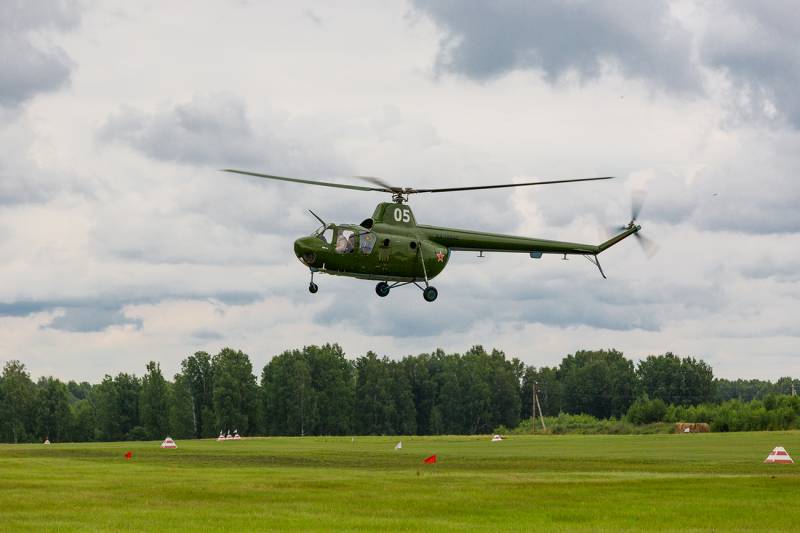
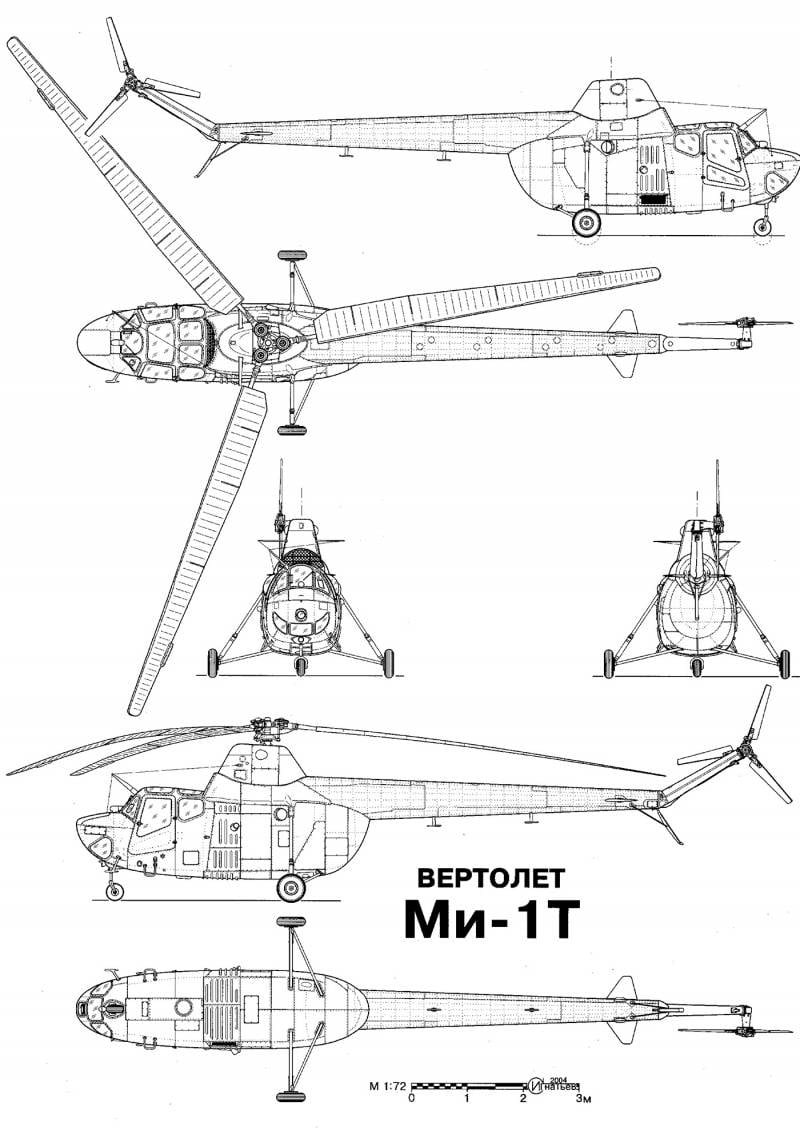
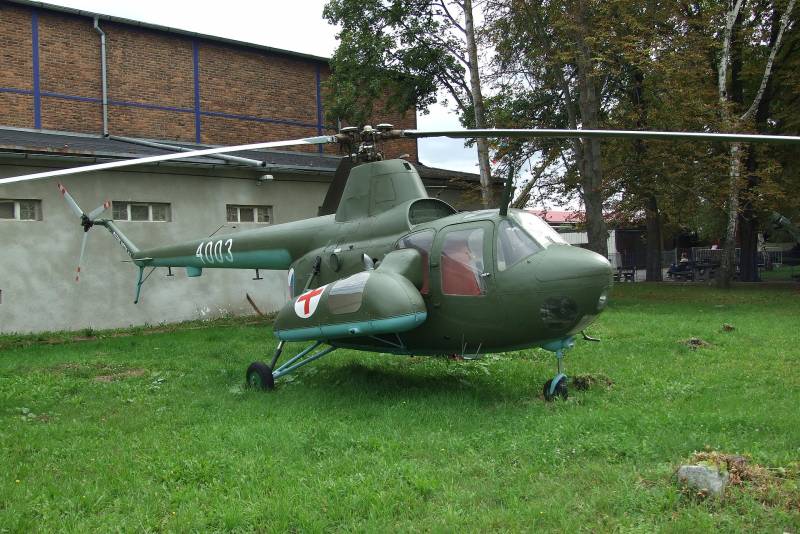
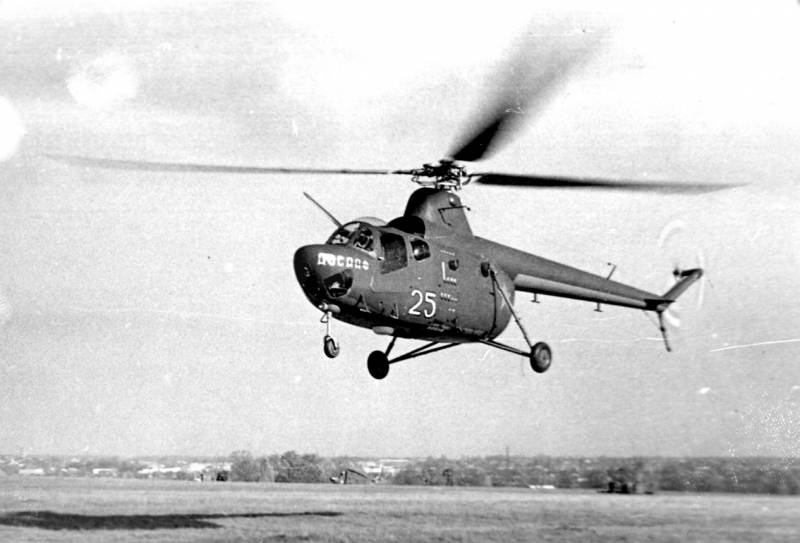
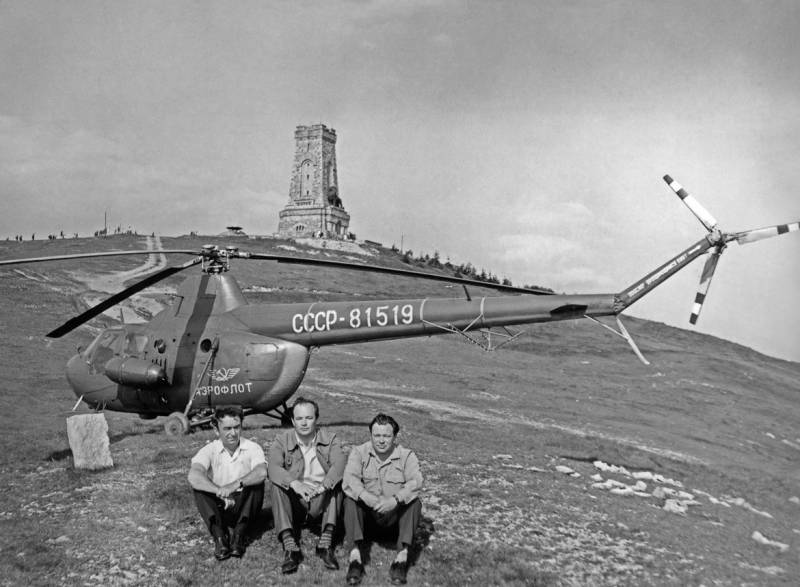
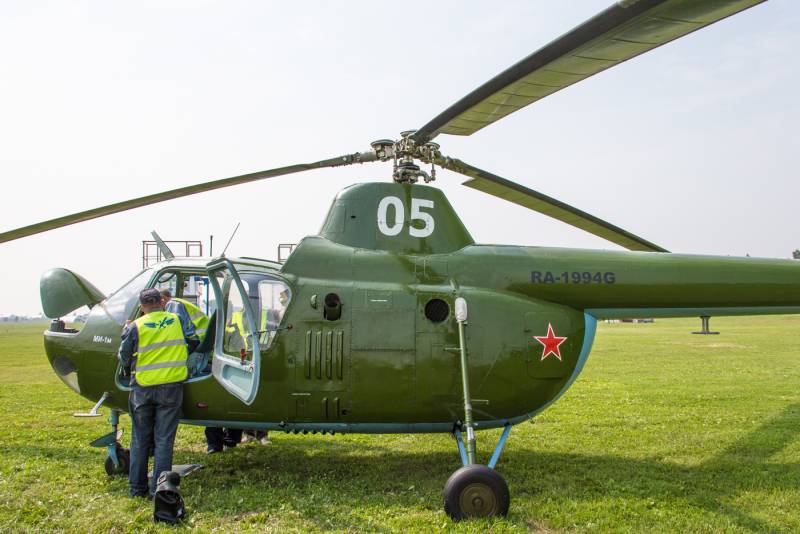
Information